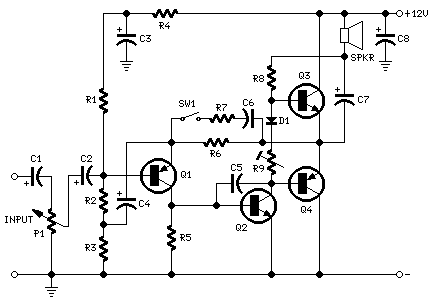Mini-box 2W Amplifier
Circuit diagram:

Parts:
Device purpose:
This amplifier was designed to be self-contained in a small loudspeaker box. It can be feed by Walkman, Mini-Disc and CD players, computers and similar devices having line or headphone output. Of course, in most cases you'll have to make two boxes to obtain stereo.
The circuit was deliberately designed using no ICs and in a rather old-fashioned manner in order to obtain good harmonic distortion behaviour and to avoid hard to find components. The amplifier(s) can be conveniently supplied by a 12V wall plug-in transformer. Closing SW1 a bass-boost is provided but, at the same time, volume control must be increased to compensate for power loss at higher frequencies.
In use, R9 should be carefully adjusted to provide minimal audible signal cross-over distortion consistent with minimal measured quiescent current consumption; a good compromise is to set the quiescent current at about 10-15 mA.
To measure this current, wire a DC current meter temporarily in series with the collector of Q3.
Technical data:
Output power: 1.5 Watt RMS @ 8 Ohm, 2.5 Watt @ 4 Ohm, 3.5 Watt @ 2 Ohm
(1KHz sinewave)
Sensitivity: 100mV input for 1.5W output @ 8 Ohm
Frequency response: 30Hz to 20KHz -1dB
Total harmonic distortion @ 1KHz & 10KHz: Below 0.2% @ 8 Ohm 1W, below
0.3% @ 4 Ohm 2W, below 0.5% @ 2 Ohm 2W.






